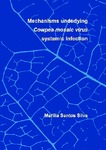Use este identificador para citar ou linkar para este item:
http://www.alice.cnptia.embrapa.br/alice/handle/doc/566152Registro completo de metadados
| Campo DC | Valor | Idioma |
|---|---|---|
| dc.contributor.author | SILVA, M. S. | pt_BR |
| dc.date.accessioned | 2011-04-10T11:11:11Z | pt_BR |
| dc.date.accessioned | 2011-04-10T11:11:11Z | pt_BR |
| dc.date.available | 2011-04-10T11:11:11Z | pt_BR |
| dc.date.available | 2011-04-10T11:11:11Z | pt_BR |
| dc.date.created | 2005-11-21 | pt_BR |
| dc.date.issued | 2004 | pt_BR |
| dc.identifier.citation | 2004. | pt_BR |
| dc.identifier.isbn | 90-8504-038-8 | pt_BR |
| dc.identifier.uri | http://www.alice.cnptia.embrapa.br/alice/handle/doc/566152 | pt_BR |
| dc.description | Over the past decade, intensive research has supplied detailed information on the mechanisms of CPMV replication and subsequent cell-to-cell movement (see above). However, the mechanisms leading to systemic infection, i. e. viral vascular movement and host responses to the infection are far less understood and were subject of the research described in this thesis. As at the onset of this thesis research no information was available on the route via which CPMV virus spreads in its cowpea host, in Chapter 2 infection of different plant tissues, following mechanical inoculation of primary leaves, was recorded as function of time GFP-expressing recombinant viruses and electron microscopy. In particular the aspects of virus loading into and unloading from the phloem were studied in detail. In Chapter 3 studies were carried out to determine the form in which CPMV circulates through the vasculature to achieve systemic infection. As viruses face a variety of barriers and host defence responses during infection, in Chapters 4 and 5 their effect on CPMV infection was analysed. In Chapter 4, the impact of RNA silencing on early CPMV indection in the permissive host N. benthamiana was examined, while in Chapter 5 resistance determinants were tested for their involvement in limiting CPMV infection to the inoculated leaf of the semi-permissive host Nicotiana tabacum. Since N. tabacum supports only virus replication and cell-to-cell movement, this plant species was interesting to mechanistically separate CPMV cell-to-cell movement from vascular movement. Hence several experiments with this plant aimed at a more specific analysis of the systemic spread process alone. Finally in Chapter 6 the experimental results described in the previous chapters are discussed and a speculative model for CPMV vascular movement is presented. Moreover, the various virus-host interactions which may occur during virus infection and which contribute to the success or failure of CPMV systemic infection are put into perspective. | pt_BR |
| dc.language.iso | eng | eng |
| dc.rights | openAccess | eng |
| dc.title | Mechanisms underlying cowpea mosaic virus systemic infection. | pt_BR |
| dc.type | Teses | pt_BR |
| dc.date.updated | 2017-06-29T11:11:11Z | pt_BR |
| dc.subject.thesagro | Feijão de Corda | pt_BR |
| dc.subject.thesagro | Mosaico | pt_BR |
| dc.subject.thesagro | Planta | pt_BR |
| dc.subject.thesagro | Resistência Genética | pt_BR |
| dc.subject.thesagro | Variedade Resistente | pt_BR |
| dc.subject.nalthesaurus | Cowpea mosaic virus | pt_BR |
| dc.description.notes | Tese (Doutorado) - Wageningen University, Netherlands. Orientador: R. W. Goldbach, Co-Orientadores: Ir W. M. van Lent e Ir J. Wellink. | pt_BR |
| dc.format.extent2 | 118 p. | pt_BR |
| riaa.ainfo.id | 566152 | pt_BR |
| riaa.ainfo.lastupdate | 2017-06-29 | pt_BR |
| Aparece nas coleções: | Tese/dissertação (CPAC)  | |
Arquivos associados a este item:
| Arquivo | Descrição | Tamanho | Formato | |
|---|---|---|---|---|
| silvam01.pdf | 8.5 MB | Adobe PDF |  Visualizar/Abrir |









